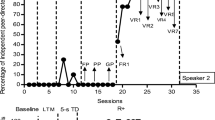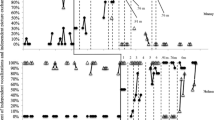Abstract
This study compared the total amount of training time and total number of trial blocks for individuals with severe developmental disabilities to acquire mands under control of unconditioned establishing operations and mands under control of transitive conditioned establishing operations for manual sign and for the Picture Exchange Communication System (PECS). Also examined was the generalization of mands across settings and communicative partners, as well as the emergence of untrained tacts and intraverbals for mands acquired using PECS. Mands for preferred items and for items needed to complete a chained task were acquired more rapidly and in fewer training blocks for PECS than for manual sign. Moreover, mands established using PECS generalized across settings and communicative partners. Finally, untrained tacts and intraverbals using PECS were shown to emerge for some of the participants following PECS training. These results suggest that PECS may be a viable alternative communication system for adults with severe developmental disabilities who have little or no history of systematic instruction and limited imitative repertoires.
Similar content being viewed by others
References
Bondy, A. S., & Battaglini, K. (1992). A public school for students with autism and severe handicaps. In S. Christenson & J. C. Conoley (Eds.), Home-school collaboration: Enhancing children’s academic and social competence (pp. 223–242). Silver Spring, MD: NASP.
Bondy, A. S., & Frost, L. A. (1993). Mands across the water: A report on the application of the picture exchange communication system in Peru. The Behavior Analyst, 16, 123–128.
Bondy, A. S., & Frost, L. A. (1994). The picture exchange communication system. Focus on Autistic Behavior, 9, 1–17.
Bondy, A., Tincani, M., & Frost, L. (2004). Multiply controlled verbal operants: An analysis and extension to the picture exchange communication system. The Behavior Analyst, 27, 247–261.
Carr, E. G., Kologinsky, E. (1983). Acquisition of sign language by autistic children II: Spontaneity and generalization effects. Journal of Applied Behavior Analysis, 16, 297–314.
Chambers, M., & Rehfeldt, R. A. (2003). Assessing the acquisition and generalization of two mand forms with adults with severe developmental disabilities. Research in Developmental Disabilities, 24, 265–280.
Charlop-Christy, M. H., Carpenter, M., Le, L., LeBlanc, L. A., & Kellet, K. (2002). Using the picture exchange communication system (PECS) with children with autism: Assessment of PECS acquisition, speech, social communicative behavior, and problem behavior. Journal of Applied Behavior Analysis, 35, 213–231.
DeLeon, I. G., & Iwata, B. A. (1996). Evaluation of a multiple-stimulus presentation format for assessing reinforcer preferences. Journal of Applied Behavior Analysis, 29, 519–533.
Frost, L., & Bondy, A. (2002). The Picture Exchange Communication System Training Manual. Newark, DE: Pyramid Educational Products, Inc.
Gregory, M., DeLeon, I. G., Richman, D. M. (2005, May). Structured assessment to predict ease of acquisition for manual sign and picture exchange communication systems. Paper presented at the 31st Annual Convention of the Association for Behavior Analysis, Chicago, IL.
Hall, G., & Sundberg, M. L. (1987). Teaching mands by manipulating conditioned establishing operations. The Analysis of Verbal Behavior, 5, 41–53.
Lamarre, J., & Holland, J. G. (1985). The functional independence of mands and tacts. Journal of the Experimental Analysis of Behavior, 43, 5–19.
Michael, J. (1988). Establishing operations and the mand. The Analysis of Verbal Behavior, 6, 3–9.
Michael, J. (1993). Establishing operations. The Behavior Analyst, 16, 191–207.
Miller, J. (1993). Augmentative and alternative communication. In M.E. Snell (Ed.), Instruction of Students with Severe Disabilities (4th ed., pp.319–346). New York: MacMillian.
Miller, C., Collins, B. C., & Hemmeter, M.L. (2002). Using a naturalistic time delay procedure to teach nonverbal adolescents with moderate to severe mental disabilities to initiate manual signs. Journal of Developmental and Physical Disabilities, 14, 247–261.
Mirenda, P. (2003). Toward a functional augmentative and alternative communication for students with autism: Manual signs, graphic symbols, and voice output communication aids. Language, Speech and Learning Services in Schools, 34, 203–216.
Schwartz, I. S., Garfinkle, A. N., Bauer, J. (1998). The picture exchange communication system: Communicative outcomes for young children with disabilities. Topics in Early Childhood Special Education, 18, 144–159.
Sigafoos, J. (1998). Assessing conditional use of graphic mode requesting in a young boy with autism. Journal of Developmental and Physical Disabilities, 10, 133–151.
Sigafoos, J., Doss, S., & Reichle, J. (1989). Developing mand and tact repertoires in persons with developmental disabilities using graphic symbols. Research in Developmental Disabilities, 10, 183–200.
Skinner, B.F. (1957). Verbal Behavior. Engelwood Cliffs, NJ: Prentice Hall.
Sundberg, M. L. (1993). The application of establishing operations. The Behavior Analyst, 16, 211–214.
Sundberg, M. L. (1993). Selecting a response form for nonverbal persons: Facilitated communication, pointing systems, or sign language? The Analysis of Verbal Behavior, 11, 99–116.
Watkins, C. L., Pack-Teixeira, L., & Howard, J. S. (1989). Teaching intraverbal behavior to severely retarded children.. The Analysis of Verbal Behavior, 7, 69–81.
Author information
Authors and Affiliations
Corresponding author
Rights and permissions
About this article
Cite this article
Ziomek, M.M., Rehfeldt, R.A. Investigating the Acquisition, Generalization, and Emergence of Untrained Verbal Operants for Mands Acquired Using the Picture Exchange Communication System in Adults With Severe Developmental Disabilities. Analysis Verbal Behav 24, 15–30 (2008). https://doi.org/10.1007/BF03393054
Published:
Issue Date:
DOI: https://doi.org/10.1007/BF03393054




